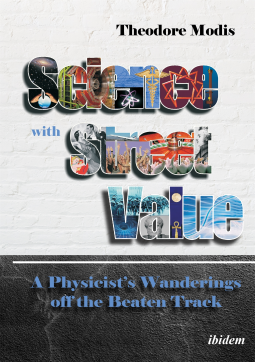
Science with Street Value
A Physicist's Wanderings off the Beaten Track
by Theodore Modis
This title was previously available on NetGalley and is now archived.
Send NetGalley books directly to your Kindle or Kindle app
1
To read on a Kindle or Kindle app, please add kindle@netgalley.com as an approved email address to receive files in your Amazon account. Click here for step-by-step instructions.
2
Also find your Kindle email address within your Amazon account, and enter it here.
Pub Date Oct 20 2020 | Archive Date Jan 27 2021
Columbia University Press | ibidem Press
Talking about this book? Use #SciencewithStreetValue #NetGalley. More hashtag tips!
Description
This book will titillate the mind of all science-friendly readers.
Available Editions
| EDITION | Other Format |
| ISBN | 9783838214474 |
| PRICE | $17.90 (USD) |
Average rating from 1 member
Featured Reviews
 David W, Media/Journalist
David W, Media/Journalist
Science With Street Value is an autobiography written in the third person. That makes it artificial-sounding, as if the narrator was a fly on the wall, wherever “Ted” (Theodore Modis) was or went. The fly also knew all his thoughts, feelings and rationales. It is disconcerting enough to make the reader miss the point.
The point, as far I can tell, is that Ted lives his life noticing all the physics underlying everything he does, is, observes, and ponders. The narrator quotes Ted: “(Science) is meant to deliver value by all possible means, including ways not anticipated by scientists.”
It means he looks at familiar things in different ways: Repeated identical stimulation causes dullness. Lack of variety deadens sensitivity. Man can last longer without food than he can without water, and without air he can’t survive at all. No two people see the same thing in the same way.
As Ted’s life progresses, he gets more and more sophisticated in his appreciation and application of physics. He is drawn to a quasi-spiritual group (Gurdjieff), which influences him for the rest of his life. He follows it to its roots in Europe and becomes a member. Their lifelong struggle is called The Work, a Talmudic quest of self-discovery that never ends. He managed to get work in Switzerland at CERN, then at Digital Equipment, and opened his own consulting business. He has written several books, generally focused on forecasting and prediction, and advised technical journals on others’ papers and books.
From time to time Ted waxes philosophical: A three dimensional world is the coldest, most separate world. Growing up in the three dimensions features loneliness and desolation. The more dimensions, the more commonalities emerge. To completely describe something, we need six dimensions: three physical, one of time, one for all lifetimes (repetitions in time), and a sixth in all possibilities including unimaginable ones.
He also propounds numerous facts that are at very least debatable: War will disappear from the face of the earth only when cultural differences disappear. An expenditure of 15% of one’s income is equivalent to expending 15% of one’s energy. Life is like a battery: the potential difference between those who have money and those need it drives the economy. Applying his favorite construct, the S-curve, he has decided that Mozart had written 90% of his music by the time he died in his mid-thirties. So we didn’t miss much by his early passing.
Modis thinks he can predict creative output using the S-curve, and thereby show when people have outlived their creativity and productivity. He says that most people who die of old age have reached 90% of their potential. I wonder what Picasso’s life would do to his theory. Or AE Hotchner or FDR for that matter.
Ted really locked on to Kondratieff’s wave theory, which posits that things happen in 56-year cycles. But this is observation, not physics. As Ted must know, the universe does not work on Man’s conception of time. Man invented time, based on observations in this tiny corner of the universe, and measures everything by it. So while Ted has managed to find numerous examples of repetition that (more or less) match the 56 year cycle, most events don’t, and there is no physics basis for it.
He also gets tangled up in astrology, which would drown the credibility of any physicist, making his whole body of work suspect. So While Theodore Modis likes to think he is living a life of applied physics, I’m not sure it is worth a book.
David Wineberg



